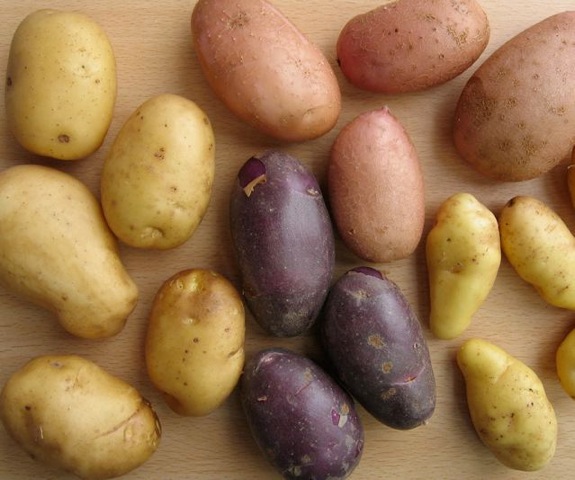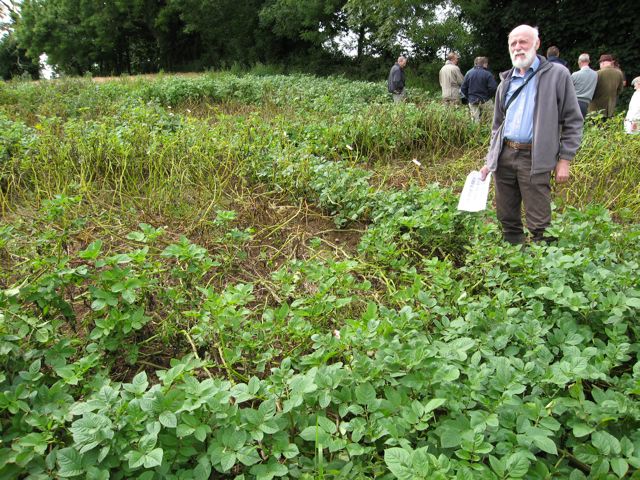What do you get when you cross crowd funding with plant breeding? At the Sárvári Research Trust, it’s the chance for ordinary gardeners to have a stake in the future.
I am hugely fortunate to live within a buzzard’s glide of one of the most exciting and inspiring plant breeding projects on earth. Now that’s a big statement for a project run by a small team fuelled by dedication, determination and a resolutely ‘can do’ attitude – but the fruits (well, the tubers) of this project are nothing less than transformative, whether we’re talking garden, allotment, market garden or farmer’s field.
This initiative ticks all of the boxes that guide us towards more earth-friendly ways of gardening. It has quietly steered a path through the storms raging around the future of plant breeding, not least the rumbling rumpus over genetically modified (GM) crop plants. This project now needs gardeners like you and me to till fertile ground on which it can continue its pioneering work.

Just some of the blight-beating spuds from the Sárvári Research Trust’s breeding work which we now plant in our gardens each spring. Clockwise, from left: white-skinned ‘Sárpo Shona’, pink ‘Sárpo Una’, elongated finger-like tubers of ‘Kifli’, and dark-skinned ‘Blue Danube’.
In 2002 the Sárvári Research Trust (SRT) was established just outside Bangor, in North Wales, under the leadership of research director Dr David Shaw. Its aim is to develop a range of potatoes which are resistant to the ravages of late blight disease caused by the fungus-like Phytophthora infestans. To do this, SRT takes promising new strains of potato bred during the last 40 years by the Hungarian Sárvári family, using time-honoured, non-GM techniques. David and his team then plant, grow, cook, taste and rigorously assess these newcomers to find those with the potential to catch the eye of potato growers large and small.
There are now seven varieties of ‘Sárpo’ (‘Sárvári’ plus ‘potato’, pronounced ‘sharpo’) potatoes available, including the iconic ‘Sárpo Mira’, a pink-skinned maincrop with jaw-dropping blight-resistance that’s now the European yardstick against which all other resistance claims are measured. Others include dark-skinned ‘Blue Danube’, another maincrop and a fine roaster, and ‘Sárpo Shona’, a productive, multipurpose, white-skinned early maincrop.
My own jaw has dropped almost every summer over the last 10 years, at the SRT’s annual open days. In carefully organised trials, blocks of different potato varieties are grown side by side to form a patchwork that changes dramatically during summer, as late blight takes hold. By early August there’s a familiar chessboard-like pattern: bare, brown and dead squares, where the leafy tops (haulms) of other varieties have been completely destroyed by blight, bang up alongside healthy, bright green and still-growing squares of Sárpos.
None of the trial plants are sprayed with chemical fungicide; protecting the blight-susceptible varieties in the trial (some of which are still listed as ‘blight-resistant’ in catalogues) would require weekly protective sprays throughout the summer when blight spores are airborne. (Outbreaks have been so intense this summer that farmers – those whose land was not too waterlogged to access – have had to spray even more frequently.) To see the Sárpos growing healthily, during some of the worst summers for late blight ever recorded, and with not a whiff of fungicide anywhere, has been impressive.

But it was ill-judged comments from the Potato Council (which looks after the interests of big potato farmers) which really shone a light on just how impressive the Sárpos are. In the process of trying – without justification – to blame gardeners for this year’s blight outbreak, they enlightened us all about how energy-intensive commercial potato growing is. The problem is not just the oil-based fungicide sprays, made using energy-intensive processes; there’s the equipment needed to do the spraying, not to mention the fossil fuel required to power the equipment. Then there’s the fertiliser and copious watering needed to get a decent harvest, and the additional energy required to keep harvested potatoes cold while in storage.
By contrast, Sárpos will give respectable results on even middling soils, do well in dry spells, and can be stored in cool conditions for months without sprouting. They’re the ultimate low-input, high-output vegetables. Among the seven varieties, all of which are ideal for organic growing, there are boilers, mashers, bakers, chippers and salad varieties. There are other Sárpos in the offing, awaiting trial – and that’s where you and I come in.
It costs many thousands of pounds and takes several years to put a promising new potato variety through all the necessary hoops before it’s named and goes on sale. Although thousands of us have already bid farewell to late blight by growing the Sárpos, and although they’re being grown in increasing quantity by savvier farmers, the wider food sector’s fickleness means that they’re yet to play a bigger role in more sustainable food production. To take the SRT’s game-changing work forward, David Shaw and his team need to expand their production of ‘seed’ potatoes and introduce more new blight-busting Sárpo varieties – without the dizzying sums of money that are available to develop GM potatoes. So they’ve launched what is possibly a unique opportunity for gardeners (or anyone else) with a passion for spuds. We are being invited to offer support not just financially, but also by playing an active dirt-under-the-fingernails part in helping to plot- and kitchen-test a new and as yet unnamed Sárpo variety.

To put the new Sárpo variety through all the various official hoops, the SRT have launched a ‘crowd fund’ project with the aim of raising £10,000 (they were well over halfway there at the time of writing). They are inviting backers to contribute time, skills and, crucially, money. You can sign up as a ‘friend’ for £10, and be invited to SRT’s potato day in early 2013, or give more and receive extra benefits, right up to becoming a ‘go getter’ who puts up £500 and receives a barrowload of perks, including a special potato-themed dinner.
But this is about much more than mere money, vital though that is. This is about the future. It’s about a unique chance for us to invest in ways of gardening that cultivate the earth with a far gentler touch. It’s about having an eye for more than just monetary gain; the growth-is-god trade magazine which declared that the SRT’s supporters were ‘unlikely to see a direct return on their investment’ shows how easy it is to view the world through the chilling, myopic lens of profit. The SRT initiative is also about joining in and contributing a new type of dual-fuel – money and enthusiasm – to one of the most inspirational plant breeding projects there is.
I’ve chipped in and have already harvested some ‘feel good’ buzz. Much of that comes from knowing that future gardeners will reap the benefits long after I’ve gone back to pushing up daisies – or perhaps even potatoes.
Find out more about the Sárvári Research Trust’s crowd funding project, and become a backer here.
Text and images © John Walker, except ‘crow’ © Sárvári Research Trust


